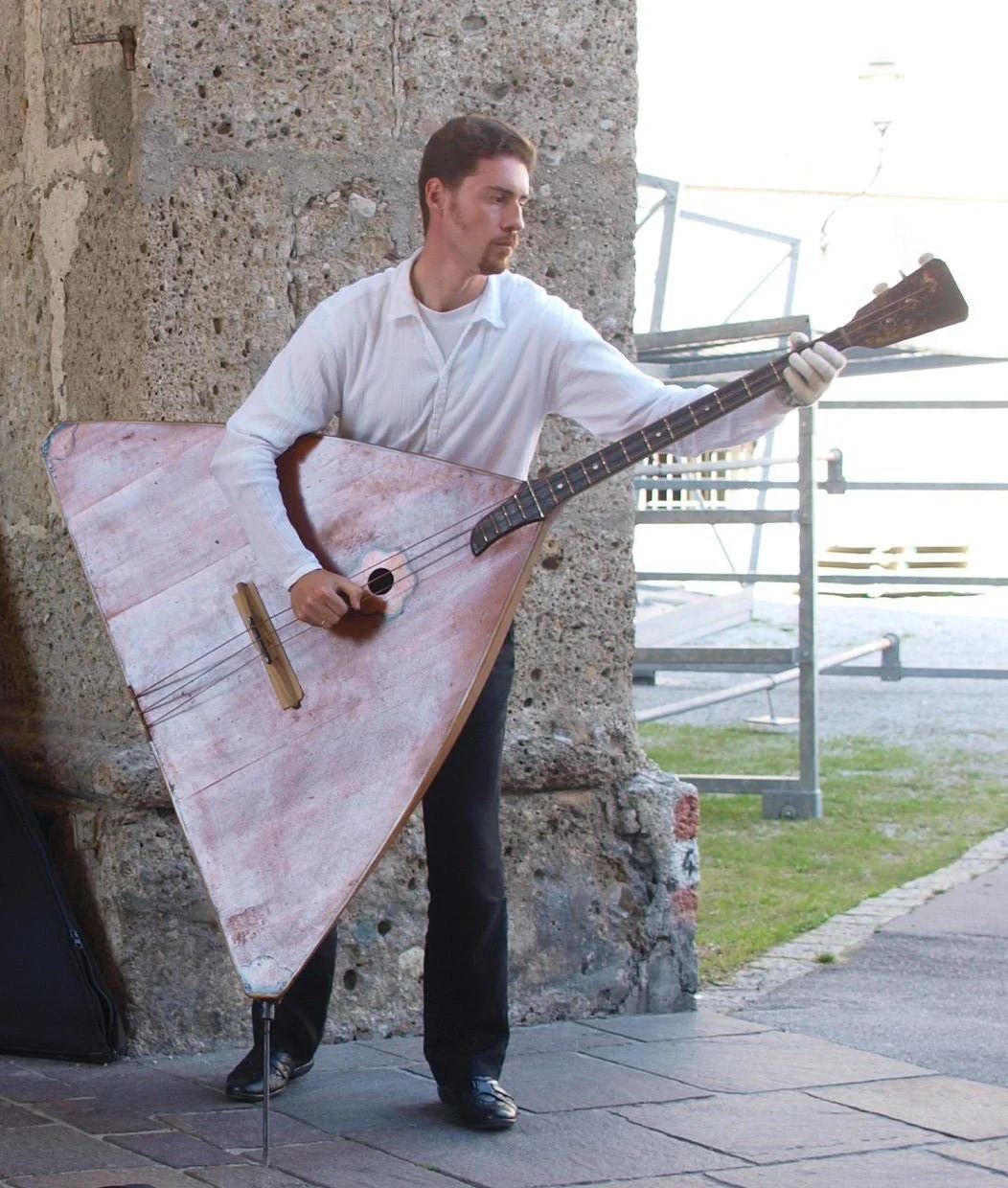A distinctive long-necked three-stringed lute used in traditional Russian folk and dance music with a triangular body, this instrument has short sustain with a small sound hole, so requires rapid strumming or plucking, and comes a range of sizes and tunings. While lutes have been around for centuries, it was the Russian player V.V. Andreyev (1861-1918) who revolutionised and modified its design with gut or steel strings, a flat back and slightly arched belly, improving its sound, and leading to six sizes – the smallest piccolo (b’-e”-a” - “dischord” tuning) to prima - the most common (e’-e’-a’), secunda (a-a-d’), alto balalaika (e-e-a), bass (E-A-d), and largest, the contrabass (E’-A’-D). Sometimes lower guitar tuning of minor thirds (E’-A’-D) is used. There is also a far rarer, mostly obsolete small descant version. The thumb is usually used for chords o on the lower strings
The word first appeared in 1688, later in a wedding document signed by Peter the Great in 1714, and in various literature, including Nikolai Gogol's Dead Souls. As a result of Andreyev’s work, the instrument grew in popularity and later led to the formation of the Osipov State Russian Folk Orchestra, and balalaika virtuosi such as Boris Feoktistov and Pavel Necheporenko in the 20th century. The Red Army Choir, even replaced violins, violas, and violoncellos with orchestral balalaikas and domras, the rounder-bodied equivalent found in Belarusian and Ukrainian folk.
The balalaika has cropped up in a variety of rock and pop music, including Kate Bush’s brother Paddy playing it on her hits Babooshka and Running Up That Hill, and Ian Anderson on Jethro Tull’s songs Jeffrey Goes to Leicester Square and Fat Man. Norway’s Katzenjammer play two contrabass models, each with cats painted on the front.
Katzenjammer with a balalaika
In lyrics the Beatles give the instrument a mention on Back In The USSR:
“Let me hear your balalaikas ringing out
Come and keep your comrade warm …”
And on The Scorpions’ huge hit, Winds of Change, about the end of the Soviet Union and other Eastern European revolutions also refers to it:
“For peace of mind
Let your balalaika sing
What my guitar wants to say.”
In film, the instrument for example is used in the score, an on camera, for David Lean’s 1965 Doctor Zhivago, as well as Charlie Chaplin’s 1931 feature City Lights.
Here is a demonstration with contemporary player Jenya Kazantsev:
And an orchestral recital with seven-year-old prodigy Anastasiia Tiurina:
And here’s Ensemble Balalaika ensemble playing a medley. Look out for the contrabass on the left:
And here The Balalaika Trio play a theme from Dr Zhivago:
So then, any more balalaika tunes or references come to mind? Feel free to share any further ones from songs, or even film, art or other contexts in comments below.
You can also get in touch the contact page, and also visit us on social media: Song Bar Twitter, Song Bar Facebook. Song Bar YouTube. and Song Bar Instagram. Please subscribe, follow and share. New to comment? It is quick and easy. You just need to login to Disqus once. All is explained in About/FAQs ...
Song Bar is non-profit and is simply about sharing great music. We don’t do clickbait or advertisements. Please make any donation to help keep the Bar running:


